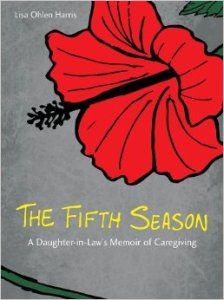 “Gee, your mom is so nice,” I remember saying to one of my sisters-in-law on my wedding day. Her lips formed a sly grin and she said, “Well, she doesn’t want to be one of those mothers-in-law.”
“Gee, your mom is so nice,” I remember saying to one of my sisters-in-law on my wedding day. Her lips formed a sly grin and she said, “Well, she doesn’t want to be one of those mothers-in-law.”
Her words evoked an image of a nosy, demanding, rebuking, hovering gadfly—not my husband’s mother. To think she cared how I felt and tried to preempt the classic mother-in-law-daughter-in-law squabbles touches me to this day. Even so, two headstrong, independent, and sensitive women are bound to occasionally step on each other’s toes.
Lisa Ohlen Harris’s memoir, The Fifth Season: A Daughter-in-Law’s Memoir of Caregiving, arrived just after my mother-in-law had died following a yearlong battle with brain cancer. As her health deteriorated, my sisters-in-law and I discussed what we’d do if she needed long-term care. Would we take turns caring for her in her home? Or would take her to live with one of us?
Lisa Ohlen Harris tells the story of how she, her husband, and widowed mother-in-law, Jeanne, purchased a big house they all could share. From the start, Harris realizes that Jeanne set a poor example to her four young daughters, especially regarding health and nutrition. Jeanne’s a smoker, who lives off of Diet Cokes, junk food, and sugary snacks, which she gleefully shares with her granddaughters.
When Jeanne develops a relentless cough and shortness of breath, doctors diagnose her with emphysema. Thus begins a seven-year-long ordeal in which Harris cares for her dying mother-in-law who’s often needy and seems slightly unappreciative of Harris’s care. Her days fill with tasks such as bathing Jeanne, dressing her wounds, checking her oxygen, shuttling her to and from medical procedures. No time is left over for her daughters, let alone herself.
In the early phases of Jeanne’s illness, Harris helps her mother-in-law file an order that states that no extraordinary measures should be used to keep her alive—to prevent a life riddled with pain or sustained on machines. At first the order seems clear, but then “extraordinary” becomes more and more ambiguous. As Harris describes it, “Jeanne is shamed into doing what she doesn’t want to do in a myriad of small treatments that add up to lots of pain and frustration and helplessness. She is forced to endure pain in order to live in continuing pain. No one asks what Jeanne wants…. I can’t advocate for her—they’ll think I’m homicidal.”
When Harris shares her concerns with her husband, he responds, “A life-saving doctor can’t understand why someone would decide at the end of her life that she doesn’t need to experience any more pain, even in exchange for more time.”
As a result, Jeanne’s death is long and painful. Harris and her husband forgo an opportunity for her husband to accept a better teaching position, but dismiss it knowing Jeanne could not survive the move. It’s a huge family sacrifice, but one of many loving decisions Harris and her husband make in order to care for her. Harris dotes so much on Jeanne, the medical staff assumes she must be a daughter. “I’ve learned what her face looks like when she needs more oxygen; I see her nose is dripping and hand her a tissue before she feels it herself…,” writes Harris. She bathes her, rubs her skin with lotion, and keeps up her appetite by feeding her the foods she loves, but won’t feed her own family: “grits, bananas, pudding, Miracle Whip and bologna loaf on white bread, French dressing over cottage cheese, sausage gravy over biscuits….”
While reading, I had to pause time from time to time and consider, would I have done this? Could I have taken in my mother-in-law—as nice as she was—and cared for her in my home? It would have been hard—for me and for her. However, she died so quickly, we never had a chance to seriously consider that option. Even so, 65 million Americans care for sick and aging relatives in their homes.
During this ordeal, Harris worked hard and persisted as Jeanne’s advocate. She’s candid about her conflicted emotions; however, any reader can see the two women shared a deep bond and struggled to the very end to resolve life in dignity and peace.
___
Debbie Hagan is book reviews editor for Brevity, editor-in-chief of Art New England and a writing instructor at New Hampshire Institute of Art. Her essays have recently appeared in Brain, Child and the anthology Dime Story.
